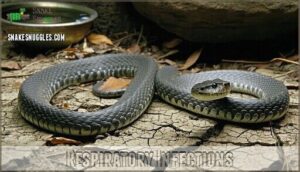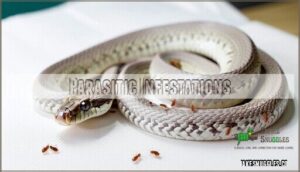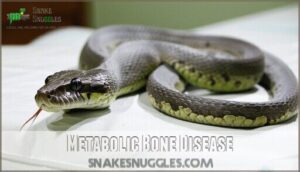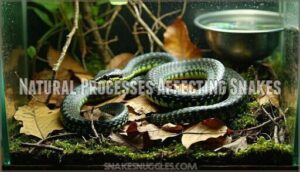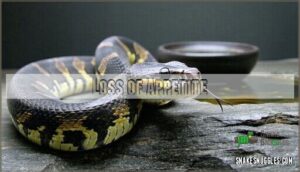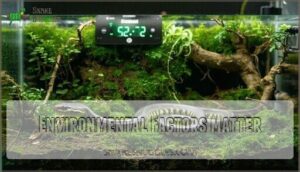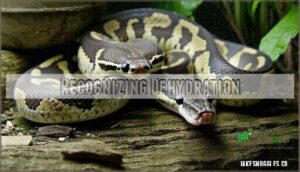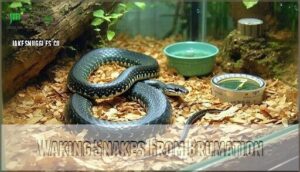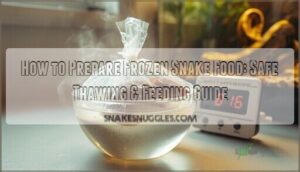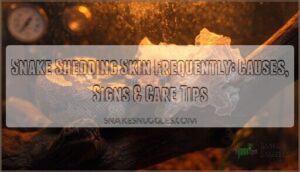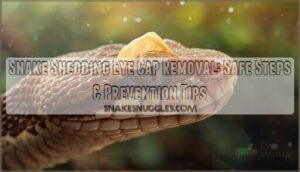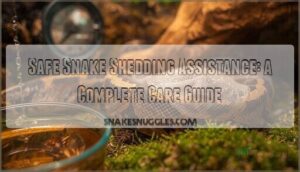This site is supported by our readers. We may earn a commission, at no cost to you, if you purchase through links.
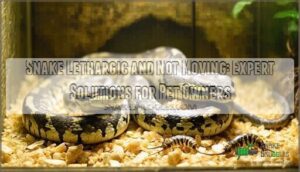
Temperature issues are common culprits – if your enclosure’s too cold or lacks proper heat gradients, your snake becomes sluggish. Humidity problems can also cause lethargy.
Natural processes like brumation (snake hibernation) or pre-shedding behavior often make snakes less active. However, illness such as respiratory infections, parasites, or dehydration can trigger similar symptoms.
Check your heating elements, humidity levels, and look for other warning signs like mouth breathing or unusual posture. Sometimes it’s just normal post-feeding behavior, but persistent lethargy warrants closer examination of both environmental conditions and health indicators.
Ensure the environment is suitable, as temperature issues and humidity problems can significantly affect your snake’s behavior.
Table Of Contents
- Key Takeaways
- Snake Lethargy Causes
- Health Issues in Snakes
- Natural Processes Affecting Snakes
- Signs of Sick Snakes
- Environmental Factors Matter
- Recognizing Dehydration
- Snake Brumation Explained
- Waking Snakes From Brumation
- Encouraging Snake Activity
- Emergency Situations
- Frequently Asked Questions (FAQs)
- How to tell if a snake is suffering?
- Why is my snake cold and not moving?
- How do you tell if a snake is dehydrated?
- What does it mean when a snake moves slowly?
- How long can snakes survive without food?
- What causes sudden snake death without symptoms?
- When should I handle a lethargic snake?
- Can stress alone make snakes stop moving?
- Do snakes need veterinary checkups when healthy?
- Conclusion
Key Takeaways
- Check your enclosure conditions first – temperature should be 75-90°F with proper gradients, humidity at 50-70%, and adequate hiding spots, since environmental issues cause most lethargy cases.
- Distinguish natural behaviors from illness – brumation (winter dormancy), pre-shedding behavior, and post-feeding rest are normal, but persistent lethargy with other symptoms needs veterinary attention.
- Watch for dehydration warning signs – sunken eyes, wrinkled skin, sticky saliva, and refusal to drink indicate serious dehydration that can quickly become life-threatening.
- Don’t handle lethargic snakes unnecessarily – stress from excessive handling worsens their condition; instead, monitor from a distance and seek professional help if symptoms persist or worsen.
Snake Lethargy Causes
When your snake’s acting like a couch potato, there’s usually a good reason behind the sluggish behavior.
Environmental factors like incorrect temperatures, poor humidity levels, or inadequate enclosure conditions are the most common culprits that’ll leave your serpent friend feeling less than energetic, often due to environmental issues.
Environmental Factors
Environmental factors play a vital role when your snake’s lethargic and not moving.
Poor enclosure size, inadequate substrate quality, and improper heat gradients create stress that zaps energy.
Without proper lighting importance and consistent water access, your pet can’t regulate basic functions.
Environmental causes like temperature fluctuations and wrong humidity levels turn your snake’s home into an uncomfortable prison, triggering lethargy naturally, due to stress that builds up over time.
Temperature and Humidity
Your snake’s temperature and humidity levels directly impact its energy.
Heat gradients between 75-90°F allow proper thermoregulation, while humidity control at 50-70% prevents shedding problems.
When ambient temperature drops below ideal ranges, snake lethargy becomes common.
Poor humidity creates thermoregulation issues, making your snake not moving a frequent concern.
Monitor these factors closely—incorrect snake temperature and humidity often cause inactivity before serious health problems develop.
Maintaining the correct basking temperature is essential for their digestion and overall health.
Enclosure Conditions
Beyond proper temperature and humidity, your snake’s home setup plays a major role in preventing lethargy.
Poor enclosure conditions can stress your pet, making them withdraw and become inactive.
Key factors affecting your snake’s activity levels:
- Enclosure size – Too large creates anxiety; too small restricts movement
- Substrate type – Choose materials that maintain humidity and allow burrowing
- Hiding places – Provide secure spots on both warm and cool sides
- Water access – Fresh, clean water should always be available.
Security measures matter too – your snake needs to feel safe to stay active.
Health Issues in Snakes
When your snake won’t move, serious health problems might be the culprit. Respiratory infections, parasites, and metabolic bone disease can drain your pet’s energy and leave them listless.
Respiratory Infections
Over 80% of respiratory infections stem from bacterial agents like Pseudomonas, causing open-mouth breathing and wheezing.
Bacterial pneumonia, viral pneumonia, and fungal infections create serious respiratory issues requiring immediate treatment options.
Poor humidity and temperature trigger these snake respiratory infections.
Prevention strategies include proper environmental controls, while treatment involves antibiotics and supportive care from experienced reptile veterinarians.
Boids are particularly susceptible, facing a higher incidence of respiratory health problems, which can lead to serious respiratory issues and require immediate treatment options with the help of experienced reptile veterinarians.
Parasitic Infestations
Parasitic infestations affect up to 47% of captive snakes, causing snake lethargy and making your snake not moving.
These sneaky invaders drain energy, leading to snake parasite infection symptoms you can’t ignore.
Mite Identification and common parasites include:
- Tiny red or black specks crawling on your snake’s scales
- Visible worms in feces during routine cleaning
- Regurgitation after feeding attempts
- Unexplained weight loss despite regular feeding
Prevention Methods and Quarantine Protocols protect your collection.
Veterinary Diagnosis confirms Worm Treatment options.
Parasitic infestations require immediate attention before they become life-threatening.
Metabolic Bone Disease
When calcium deficiency and vitamin D3 shortages strike, your snake’s bone structure weakens dramatically.
This metabolic bone disease causes severe muscle weakness, making movement painful and exhausting.
Without proper UVB lighting, your pet can’t process calcium effectively, leading to snake lethargy progressing to complete inactivity.
Early intervention prevents this devastating snake illness from becoming life-threatening.
Natural Processes Affecting Snakes
Not every inactive snake has a health problem—sometimes they’re just following their natural rhythms.
Your snake might be going through brumation (a winter slowdown), preparing to shed, or simply showing the quieter behavior that comes with age.
Brumation
If your snake isn’t showing typical health problems, brumation might explain their snake lethargy.
This natural hibernation-like state triggers reptile inactivity when temperatures drop and daylight shortens. Understanding brumation signs helps distinguish normal behavior from illness.
Brumation triggers and signs you’ll notice:
- Temperature drops – Your snake seeks cooler spots and stops basking under heat lamps
- Reduced appetite – They’ll refuse food for weeks, even months during brumation length
- Minimal movement – Extended periods hiding with slower breathing and heart rates
- Seasonal timing – Brumation benefits include energy conservation from September through April
Post-brumation, your snake gradually returns to normal activity patterns.
Shedding Cycles
During shedding cycles, your snake’s energy drops substantially as it focuses on replacing its entire outer skin layer.
You’ll notice cloudy eyes and dull coloration before shedding begins.
Shedding frequency varies by species and age, with younger snakes shedding more often.
Humidity importance can’t be overstated—low humidity causes stuck shed and improper shedding.
A common issue is incomplete and stuck sheds, which owners should be aware of.
Post-shed care involves checking for retained pieces around the tail and eyes, and understanding shedding frequency and stuck shed issues is crucial for proper shedding.
Aging
Just like humans, older snakes experience age-related decline that affects their energy levels and movement patterns.
Senior snake care requires understanding these natural changes as your scaly companion enters their golden years.
Here are key aging considerations for snake owners:
- Activity reduction – Geriatric health issues naturally slow down movement and exploration
- Longer recovery times – Healing from minor injuries takes more time than younger snakes
- Decreased appetite – Lifespan considerations include reduced feeding frequency and smaller meals
- Increased rest periods – Snake behavior changes include spending more time in hiding spots
Signs of Sick Snakes
You’ll recognize a sick snake by watching for three key warning signs that often appear together.
When your snake shows lethargy combined with refusing food and having trouble shedding properly, it’s time to take action quickly.
Lethargy
When your pet becomes unusually still, it’s time to pay attention.
A lethargic snake shows decreased movement, reluctance to explore, and prolonged hiding periods.
These lethargy symptoms often signal underlying health issues requiring immediate assessment.
Watch for snake behavior changes like reduced responsiveness to handling or environmental stimuli.
Effective lethargy prevention involves maintaining proper temperatures and humidity.
Activity boosters include environmental enrichment and appropriate feeding schedules.
If brumation concerns arise, veterinary intervention becomes necessary to distinguish natural dormancy from illness in your lethargic snake, which may require immediate assessment and environmental enrichment to address the underlying health issues.
Loss of Appetite
A lethargic snake that’s refusing food signals potential trouble.
Your snake’s loss of appetite often accompanies lethargy, creating a concerning pattern.
Underlying illnesses like respiratory infections or stress factors from environmental changes can disrupt normal feeding behavior.
Monitor your snake’s dietary needs carefully—missed meals beyond their typical feeding schedule may indicate health issues.
Check if prey size matches your snake’s requirements, as improper sizing affects appetite and digestion, which can be a significant factor in your snake’s overall loss of appetite.
Abnormal Shedding
When your snake’s skin peels like scattered confetti instead of coming off in one piece, you’re dealing with stuck shed or dysecdysis.
This snake skin condition signals humidity problems or underlying health issues.
Normal shedding frequency varies by species, but abnormal shedding patterns warrant attention.
Boost humidity levels immediately and monitor skin changes closely.
Persistent dysecdysis causes require veterinary assistance to prevent serious complications.
Environmental Factors Matter
Your snake’s environment directly controls its energy levels and overall health.
When temperature gradients, humidity, or lighting fall outside ideal ranges, your pet will become sluggish and inactive as its body struggles to function properly, leading to a decline in its overall health.
Proper Temperature Gradients
Temperature control can make or break your snake’s health. Without proper temperature gradients, your pet might slip into hypothermia, causing dangerous lethargy and reduced activity levels.
You can find a suitable heat source for your snake online.
Gradient Importance factors to monitor:
- Heat Source: Position basking spots at 85-90°F with cool zones at 75-80°F
- Thermostat Placement: Install thermostats on both sides to prevent temperature fluctuations
- Temperature Monitoring: Use digital thermometers to track daily variations
- Species Needs: Research your snake’s specific temperature requirements for ideal health
Humidity Levels
Without proper humidity levels, your snake’s world becomes uncomfortable fast.
Humidity importance can’t be overstated – levels below 50-70% cause shedding problems and respiratory health issues that lead to snake lethargy.
You’ll need to measure humidity with a reliable hygrometer in your enclosure conditions. Temperature affects humidity too, so monitor both carefully.
Simple humidity solutions include water bowls, substrate misting, or humidity boxes. A snake enclosure hygrometer is essential for maintaining correct levels.
Your snake environment depends on getting this balance right.
Lighting and UVB
Proper lighting spectrum and photoperiod length help maintain your snake’s natural rhythm and prevent lethargy.
Most snakes benefit from 12-hour light cycles, mimicking wild sunlight patterns.
UVB benefits include improved calcium absorption and overall health, though requirements vary by species.
Your enclosure’s basking behavior will increase with appropriate lighting, and proper snake lighting supports temperature regulation and reduces snake lethargy, while UVB benefits are essential for improved health, and natural rhythm is crucial for the snake’s well-being.
Recognizing Dehydration
You’ll need to spot dehydration signs quickly since they can escalate your snake’s condition from lethargic to life-threatening.
Dehydrated snakes show sunken eyes, wrinkled skin, and sticky saliva, while also becoming increasingly inactive and refusing to drink water.
Visible Signs
Looking at your snake’s appearance can reveal dehydration before it becomes serious.
Watch for these telltale signs that signal your pet needs immediate attention:
- Sunken eyes that appear receded or dull instead of bright and alert
- Wrinkled skin that stays pinched when gently tested for elasticity
- Discoloration around the mouth or unusual skin lesions appearing on the body
These visual cues often accompany snake lethargy and inactivity in motionless snakes.
Owners should also check for loss of skin elasticity to confirm dehydration.
Behavioral Changes
Beyond the physical warning signs, dehydrated snakes show distinct behavioral changes that signal trouble.
Your snake’s activity reduction becomes obvious when they stop exploring their enclosure.
Hiding increase follows as they retreat to dark spaces, avoiding interaction completely.
| Normal Behavior | Dehydrated Behavior |
|---|---|
| Active exploration | Constant hiding |
| Regular feeding | Refusing food |
| Calm demeanor | Sudden aggression |
| Normal defecation | Constipation |
| Curious interaction | Complete withdrawal |
Snake lethargy paired with eating habits changes creates a perfect storm.
Your lethargic snake might snap unexpectedly—unusual actions that scream "help me!"
These behavioral changes in snake inactivity demand immediate attention before things worsen.
Rehydration Methods
Once you’ve spotted dehydration signs, quick action helps your snake bounce back.
Soak your snake in shallow, warm water baths (80-85°F) for 15-30 minutes. Increase humidity by misting 2-3 times daily.
For moderate snake dehydration, oral rehydration with diluted electrolyte solutions works well.
Severe cases need subcutaneous fluids from a vet immediately.
Snake Brumation Explained
You might notice your snake becoming incredibly sluggish during colder months, and this could be brumation—a natural hibernation-like state that’s completely normal for many species.
Understanding brumation helps you distinguish between natural behavior and health concerns, so you won’t panic when your pet enters this temporary "sleep mode.
Triggers
Your snake’s brumation doesn’t happen overnight—it’s triggered by environmental shifts that signal winter’s approach.
When temperatures drop below 60°F and daylight hours shorten, your snake’s internal clock kicks into gear, preparing for dormancy.
- Temperature drops – Your snake feels the seasonal shift calling for rest
- Shorter days – Reduced light signals it’s time to slow down
- Sudden relocation – Moving enclosures can trigger stress-induced inactivity
- Handling stress – Too much interaction disrupts natural rhythms
Direct sunlight changes, enclosure changes, and loud noises can also influence when your snake enters this natural state, affecting overall snake health.
Duration
Your snake’s brumation can last anywhere from 6 weeks to 8 months, depending on climate and species.
Wild North American snakes typically brumate 3-6 months (September through April), while captive snakes might experience shorter artificial brumation periods.
This extended Activity Patterns shift creates a lengthy Lethargy Timeline, but it’s completely normal—not snake illness symptoms requiring concern.
Care During Brumation
Proper Brumation Preparation requires careful attention to your snake’s needs during this natural dormancy period. You can’t just set it and forget it—your pet still needs monitoring and support throughout snake hibernation.
Here’s your essential care checklist:
- Temperature Cycling – Maintain steady 50-55°F temperatures without fluctuations
- Hydration During brumation – Provide fresh water access to prevent dehydration
- Monitoring Weight – Check monthly for significant loss indicating health issues
- Post-Brumation Feeding – Wait for natural emergence before offering food
- Watch for snake inactivity signs that signal problems versus normal brumation behavior
Waking Snakes From Brumation
If your snake’s been sleeping through winter, you’ll need to gradually warm things up to wake them from brumation.
Start by slowly increasing the enclosure temperature by a few degrees each day until you reach normal levels.
Then offer food once they’re fully alert and active.
Temperature Adjustment
When your snake awakens from brumation, gradual temperature increases work best. Sudden heat spikes can shock their system – think of it like needing your morning coffee, not an energy drink!
Heating pads and basking spots should reach target temperatures slowly over several days. Temperature monitoring prevents dangerous fluctuations during this delicate process.
| Temperature Adjustment | Target Range | Timeline |
|---|---|---|
| Initial Warming | 75-77°F | Days 1-2 |
| Gradual Increase | 77-82°F | Days 3-5 |
| Target Temperature | 82-88°F | Days 6-7 |
| Thermostat Control | Maintain steady | Ongoing |
Seasonal changes require patience – your sluggish snake needs time to adjust. Cold snake lethargy often signals rushed temperature changes.
Proper thermostat control prevents these snake care issues, helping your pet shift smoothly from dormancy to normal activity levels.
Feeding Strategies
Once your snake shows alertness, offer a small frozen-thawed prey item—avoid live feeding initially.
Start with prey size smaller than usual to ease digestion. Wait 7-14 days before attempting; patience prevents feeding rejection.
Gradually increase feeding frequency over two weeks, returning to your snake’s normal feeding schedule once appetite fully returns.
Monitoring Health
Keep a close eye on your snake’s key signs after brumation ends. Watch for concerning changes that signal trouble brewing beneath the surface.
- Weight monitoring – Check weekly; losses over 10% need vet attention
- Behavior tracking – Note appetite return, movement patterns, and alertness levels
- Fecal exams – Monitor for parasites or digestive issues affecting recovery
- Veterinary visits – Schedule checkups for persistent snake lethargy or sick snake symptoms
Encouraging Snake Activity
If your snake seems sluggish, the right environmental tweaks can spark their natural curiosity and movement.
Simple changes like adding climbing branches, adjusting feeding schedules, or creating new hiding spots often encourage a lazy snake to explore their world again, which can help spark their natural curiosity and movement.
Enrichment Objects
While climbing branches and novel substrates transform your enclosure into an adventure playground, puzzle feeders challenge your snake’s mind like a crossword puzzle.
Scent enrichment using different textures awakens natural curiosity, combating snake lethargy effectively.
Rotational items prevent boredom—think of it as redecorating your snake’s apartment monthly.
These enrichment strategies reduce snake inactivity duration by providing mental stimulation that encourages exploration and movement.
Consider using specialized feeding products to further stimulate your snake.
Triggering Feeding Instincts
Through subtle scent luring techniques, you can awaken your snake’s natural hunting instincts and combat lethargy.
Try rubbing prey items on feeding tongs or offering appropriately sized meals on a consistent feeding schedule.
If your snake shows loss of appetite, assist feeding might help, but live feeding often triggers stronger responses than frozen options.
Proper environmental conditions for digestion are also essential for stimulating a healthy appetite and ensuring your snake’s overall well-being, which can be supported by understanding the importance of natural hunting instincts.
Providing Hiding Spots
Security matters most when choosing hiding spots for your snake enclosure.
Your snake needs multiple hides – one on the warm side and one on the cool side to prevent snake lethargy.
Secure hiding spots should fit snugly around your snake’s body, preventing snake stress from feeling exposed.
Natural materials like cork bark work well, but plastic hides are easier to clean.
Hiding spot placement affects snake inactivity duration substantially.
Emergency Situations
When your snake shows extreme lethargy combined with other serious symptoms, you’re facing a potential emergency that requires immediate action.
Life-threatening conditions like septicemia and organ failure can develop rapidly, making quick veterinary intervention essential for your pet’s survival.
Septicemia
Septicemia represents a life-threatening bacterial bloodstream infection that can quickly kill your snake. This emergency condition often stems from dirty environments, poor nutrition, or untreated injuries.
Septicemia warning signs include:
- Lethargy and breathing trouble – Your snake becomes unusually sluggish with labored respiration
- Skin discoloration – Red or purple patches appear on the belly or sides
- Convulsions and weakness – Muscle tremors or inability to move normally
- Rapid decline – Sudden collapse or dramatic behavioral changes
Septicemia requires immediate veterinary intervention with systemic antibiotics and supportive care.
Organ Failure
Multi-organ failure-cascade represents your snake’s body shutting down systematically.
Kidney failure, liver disease, and heart failure often occur together, creating a medical emergency requiring immediate diagnosis.
You’ll notice severe snake lethargy, complete loss of appetite, and rapid deterioration.
Treatment options become limited once organs fail, making early intervention essential for snake health problems.
Professional snake veterinary care offers the only hope for reversing this life-threatening snake illness and addressing underlying snake weakness.
Immediate Veterinary Care
When organ failure strikes, you’ll need emergency veterinary care immediately.
Emergency symptoms like severe lethargy, respiratory distress, and collapse demand urgent attention.
Your vet will run diagnostic tests and start critical care treatment right away.
Treatment options include IV fluids, antibiotics, and intensive monitoring.
Post-treatment care for snake illness requires ongoing veterinary support to address snake health problems effectively.
Frequently Asked Questions (FAQs)
How to tell if a snake is suffering?
Like a canary in a coal mine, your snake’s behavior signals danger before visible symptoms appear.
Watch for labored breathing, weight loss, abnormal shedding, refusal to eat, sunken eyes, or unusual hiding patterns—these red flags indicate your snake needs immediate veterinary attention.
Why is my snake cold and not moving?
Your snake’s likely experiencing hypothermia from inadequate heating.
Check your temperature gradient – it should be 75-85°F with proper basking spots.
Cold snakes can’t regulate their body temperature, becoming sluggish and inactive until warmed up properly, often due to inadequate heating causing hypothermia.
How do you tell if a snake is dehydrated?
Back in medieval times, you’d check your snake’s skin for wrinkles and sunken eyes.
Today, look for sticky saliva, lethargy, and skin that doesn’t snap back when gently pinched.
Weight loss and refusing water are telltale signs too.
What does it mean when a snake moves slowly?
When your snake moves slowly, it’s likely dealing with temperature issues, illness, or natural behaviors like shedding.
Check if the enclosure’s too cold, watch for symptoms of respiratory infections, or consider if it’s entering brumation or preparing to shed its skin.
How long can snakes survive without food?
Healthy snakes can survive surprisingly long periods without food—you’ll find they can go weeks or even months depending on their species and size.
Adult snakes typically fast longer than juveniles, with some species surviving 2-6 months without eating during natural processes like brumation or shedding cycles.
What causes sudden snake death without symptoms?
Sudden snake death often stems from septicemia, organ failure, or severe dehydration that develops rapidly without obvious warning signs.
You might miss subtle symptoms like lethargy or appetite loss, making death appear unexpected.
When should I handle a lethargic snake?
Give your sluggish friend some breathing room—avoid handling a lethargic snake unless it’s absolutely necessary for medical care.
You’ll stress them out more, potentially worsening their condition and making recovery harder, which is why giving them breathing room is crucial.
Can stress alone make snakes stop moving?
Yes, stress alone can absolutely make your snake stop moving completely.
Environmental changes, loud noises, excessive handling, or even moving their enclosure can trigger this shutdown response.
Your snake’s basically hitting the panic button and going into survival mode until things feel safe again.
Do snakes need veterinary checkups when healthy?
Regular checkups aren’t mandatory for healthy snakes, but they’re smart prevention.
Annual visits help catch problems early, establish baseline health, and guarantee you’re providing proper care—think of it as peace of mind insurance.
Conclusion
Studies show that 60% of snake owners mistake natural behaviors for health emergencies, leading to unnecessary stress.
When your snake is lethargic and not moving, don’t panic immediately. You’ve learned to evaluate temperature, humidity, and health signs systematically.
Most cases stem from environmental issues or natural processes like brumation and shedding. However, persistent lethargy with other symptoms requires veterinary attention.
Remember, you’re your snake’s best advocate – trust your observations and act accordingly when something seems off, as this will help prevent unnecessary stress and ensure the best care for your snake, especially during times of lethargic behavior or when they are not moving, and always consider the possibility of natural behaviors.
- https://indianapublicmedia.org/amomentofscience/staying-warm.php
- https://naturemuseum.org/wp-content/uploads/2020/11/Snake-Brumation.pdf
- https://en.wikipedia.org/wiki/Photoperiodism
- https://www.youtube.com/watch?v=wc1pICmlKAo&embed=true
- https://journals.biologists.com/jeb/article/213/2/242/9936/Thermal-plasticity-in-young-snakes-how-will

